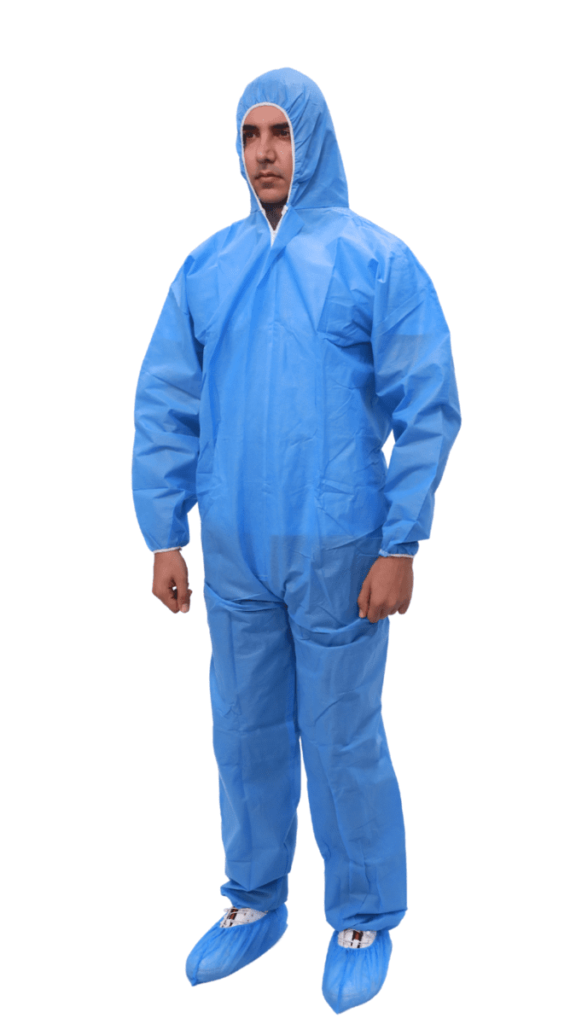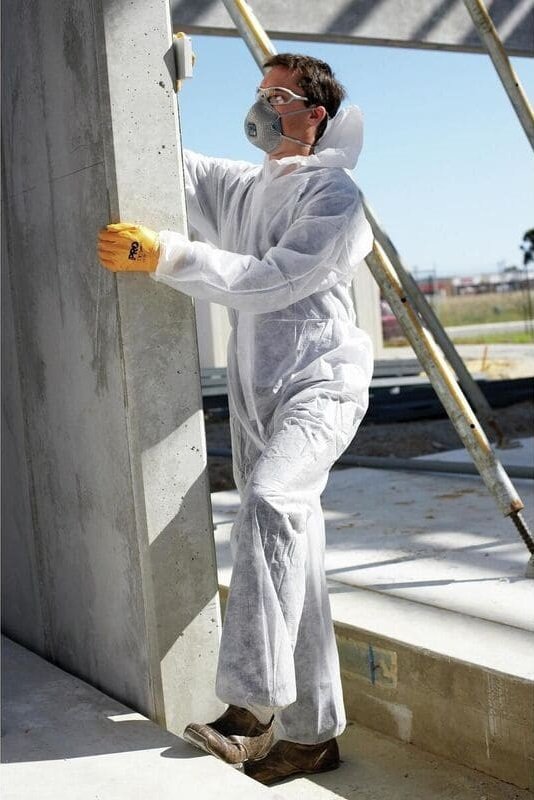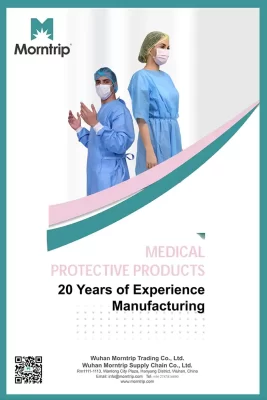Table of Contents
The demand for disposable coveralls for construction industry is rising, due to the rapid growth in construction activities, stricter safety regulations, and the need for reliable protective clothing to safeguard workers. Disposable coveralls, in particular, have become a vital solution for ensuring worker safety, offering protection against various hazards, including chemicals, dust, and physical injuries.
With the construction segment projected to grow at a compound annual growth rate (CAGR) of 8.3%(Grand View Research), the adoption of disposable coveralls is set to surge. These coveralls not only meet stringent safety standards but also provide cost-effective and practical solutions for hygiene and contamination control. In this blog, we’ll explore the benefits, material types, protection levels, and key features of disposable coveralls, along with guidance on selecting the best options for construction workers.

Benefits of Disposable Coveralls for Construction Workers
Protection from Hazards
Disposable coveralls provide essential safety for construction workers in demanding environments:
- Chemical and Biological Safety: They shield workers from harmful chemicals, dust, and biological agents, reducing health risks.
- Physical Safety: These coveralls act as a strong barrier, lowering the chance of injuries from sharp tools, debris, or abrasions.
- Flame Resistance: Flame-resistant options protect workers from burns caused by fire or hot surfaces.
Hygiene and Contamination Control
Maintaining cleanliness on construction sites is crucial, and disposable coveralls help achieve this:
- Single-Use Design: Designed for one-time use, they ensure cleanliness by removing the need for washing. They are easy to dispose of, reducing contamination risks.
- Prevention of Cross-Contamination: These coveralls stop hazardous substances from spreading to personal clothing, vehicles, or other areas, which is vital for projects requiring strict hygiene.
Cost-Effectiveness
Disposable coveralls also offer economic benefits:
- Reduced Maintenance Costs: Without the need for laundering, they save time and money, making them practical for large projects.
- Bulk Purchase Savings: Available in bulk at lower prices, they provide an affordable way to meet safety requirements.
Material Types of Disposable Coveralls for Construction

SMS (Spunbound-Meltblown-Spunbound)
Made of three non-woven layers, SMS material is durable and filters well. It resists fluids and particles, making it ideal for construction sites. The breathable design ensures comfort during long use.

Tyvek
Constructed from polyethylene fibers, Tyvek coveralls are lightweight and strong. They provide excellent protection against water, chemicals, and particles. Perfect for tasks like asbestos removal and hazardous waste handling due to their protective barriers.

Microporous Film
Combines breathability with liquid resistance. Protects against non-hazardous liquids and particles, suitable for various construction tasks. Offers both safety and comfort for general industrial applications.
Protection Levels of Disposable Coveralls for Construction
Type 5 Coverall
Designed to prevent the ingress of dust and airborne particles, including hazardous materials like asbestos. These coveralls are essential for construction sites where dust and particulate contaminants are a risk.
Type 6 Coverall
These coveralls protect against light sprays and chemical splashes, offering a lower level of chemical protection compared to Types 3 and 4. They are suitable for less hazardous construction environments where minimal chemical exposure is expected.
Must-have features of disposable coveralls for construction
Breathability
Comfort is vital during long hours on construction sites. Choose breathable coveralls made from materials like microporous film or SMS fabrics. These materials allow better air circulation, helping to prevent heat and moisture buildup during intense tasks.
Durability
Construction sites demand tough gear. Fabrics like Tyvek and SMS are strong and tear-resistant, making them reliable for harsh conditions without sacrificing safety or performance.
Chemical Resistance
Some construction tasks involve exposure to hazardous chemicals. Coveralls made from polyethylene or microporous film offer protection against these substances, providing a safe barrier for workers.
Regulatory Compliance
Always select coveralls that meet industry standards and regulations. This ensures worker safety and avoids risks associated with non-compliance.

Best Disposable Coveralls For Construction
Tyvek Coveralls
Made from Tyvek, a high-density spunbound polyethylene fibers, tyvek coveralls provide superior barrier protection against hazardous particles and liquids. Tyvek coveralls usually have features include zipper front, elastic wrist and ankle, and attached hood, offer full-body protection in various work environments, they are ideal for tasks like asbestos removal and heavy construction works.

Microporous Cat III Type 5/6 Coveralls
Microporous Cat III type 5/6 coveralls are made of microporous fabric, they can provide strong protection against hazardous particles while allowing air to pass through, ensuring safety and comfort during demanding construction tasks. Type 5/6 coveralls also meet the EN 1149-5 standards to reduce static electricity, which is crucial in flammable environments.
SMS Cat 3 Type 5/6 Disposable Coverall
Made from breathable SMS fabric, SMS Type 5/6 coveralls offer comfort and effective protection against dry hazardous particles, making them a great choice for long work hours.
Key Considerations Choose a Disposable Coverall for Construction
Material
Microporous film works well for construction workers handling liquids, particulates, and mild chemicals. It is breathable and protective, making it suitable for long wear during demanding tasks.
SMS coveralls provide protection from liquids and particulates while remaining lightweight and comfortable. They are ideal for general construction tasks requiring moderate safety measures.
Tyvek coveralls, crafted from polyethylene fibers, are lightweight, tear-resistant, and breathable. They offer strong barriers against water, chemicals, and particulates, making them perfect for tasks like asbestos removal and handling hazardous waste.
Style and design
Closure Types: Two-way zipper closure with storm flaps provide protection, adhesive zip flaps add extra sealing for high-exposure environments.
Tight Fit: Elasticated hoods, cuffs, and ankles create a snug fit to block dust and chemicals from entering.
Attached Hoods and Booties: Offer full coverage, reducing exposure to harmful substances.
Bound and Taped Seams: Improve durability and enhance barriers against liquids and particles, especially in high-risk settings.
Comfort and Fit
Preventing Overheating: Breathable materials in disposable coveralls reduce heat stress, ensuring workers remain safe and productive during extended wear.
Sizing Options: With various sizes available, these coveralls fit well around shoulders, hips, and waists. Proper fit prevents discomfort and allows easy movement, supporting diverse construction activities.
Disposable coveralls are indispensable for construction workers, offering robust protection against hazards, ensuring hygiene, and providing cost-effective solutions. With various material options like SMS, Tyvek, and microporous film, and essential features such as breathability, durability, and regulatory compliance, these coveralls cater to diverse construction needs. Selecting the right coverall enhances safety and comfort on-site.
If you’re looking for high-quality disposable coveralls or need expert guidance, Morntrip is here to help. Contact us today for professional support, and tailored solutions, and to request free samples to experience the quality firsthand!






